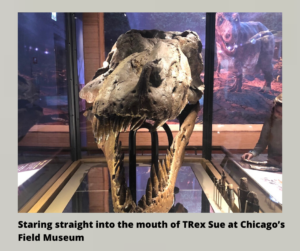“The single biggest problem with communication is the illusion that it has taken place.”
~ George Bernard Shaw
Earlier this year before the world pressed pause, I took advantage of an opportunity to visit the Field Museum in Chicago with my family. As we walked through an exhibit that measures time on earth in terms of eons, I was reminded that even though humans have been communicating with each other for close to 2 million years, we still struggle on a daily basis to do so effectively.
While I readily admit I am part of that struggle, here are three rules I try to remember and apply in an attempt to improve my interpersonal communication.
1. Listen, Don’t Talk
2. Ask, Don’t Tell
3. Leave Space
1. Listen, Don’t Talk
Many people who think they’re listening are instead only waiting to talk; there’s a significant difference between the two. Some of the more extreme ones don’t even wait that much, preferring to interrupt if forced to wait too long.
Like a search engine gone haywire, they wait for spoken keywords that match what they already wanted to say. And when one of those keywords hits their input, they launch into their already-conceived thoughts. If it happens to coincide with what the other party was talking about, it’s an unintended bonus.
The key thing to remember here is that we’re ALL guilty of doing this at times. Instead of pointing fingers at others, concentrate on being aware of this behavior in yourself. Share on X For example, if you’ve interrupted the person you’re speaking with more than once or twice, you’re probably waiting to talk instead of listening.
When you recognize this, force yourself to concentrate on what the other person is saying. When they’re done speaking respond with, “What I heard you say was,” then repeat to them a version of what you just heard, and at the end add, “is that right?” This technique forces the focus outside of your own head and short-circuits your ability to launch right into the point you want to make.
2. Ask, Don’t Tell
The last time you had to correct someone’s behavior and tell them what to do, how did they react? Were they grateful or were they defensive?
“Ask, Don’t Tell” is the verbal equivalent of a gentle nudge instead of a forceful shove. And it’s best illustrated with a story told by former Navy Seal, Leif Babin:
As a SEAL platoon commander, I found myself struggling with where to position myself in the kill house during our close-quarters training, where the team practiced clearing rooms and hallways in an urban environment. In my previous platoon, I’d been told that as an officer, my role was to stand in the back of the train.
“Why are you in the back of the train?” Jocko asked me, observing Charlie Platoon’s runs through the kill house from the catwalk above.
“I thought that was where I was supposed to be,” I answered.
“Can you tell what’s going on with your guys at the front of the train?” Jocko asked.
“I have no idea what’s going on up front,” I admitted. If I didn’t know what was going on up front, how could I lead? I certainly couldn’t help the team solve a particularly challenging problem, vector more resources to my shooters, or provide proper command and control.
“If you don’t know what’s going on, you can’t lead,” Jocko told me. “You can’t be all the way up front, because then you get sucked into every room clearance, and then you’re too far into the tactical details to provide proper command and control. Your position should be somewhere in the middle, with the bulk of your forces, close enough to the front to know what is going on, but far enough back that you aren’t in the weeds doing the tactical work.”
It made sense. It was simple, but Jocko’s guidance was illuminating. I gained confidence and fully understood where I should be as a leader.
Jocko could have just directly told Leif to move up from the back. But that wouldn’t have been nearly as effective as asking him why he was in the back and then asking him if that was helping. Asking instead of telling creates more long-term value because:
1. The other party is inherently more open and less defensive
2. It helps them understand the “why”
3. It involves the other party in the journey to the destination instead of merely being told where to go
Does that help?
3. Leave Space
When was the last time you engaged in a conversation only to wind up on the receiving end of a lecture and felt satisfied with the exchange?
There’s a secret that the best salespeople in the world know that separates them from the vast majority of sales professionals who merely get by. The average salesperson looks for places where they can start talking. The best salespeople are constantly focused on finding spots in the discussion where they can stop talking.
Leave space for the other person in the conversation. Share on X
I once worked with someone who would speak for so long before breathing that I needed a notepad and a flair for shorthand to keep up. There is one specific conversation I remember where once he came up for air, I finally had the chance to refer to my notes and say, “Ok, here are my thoughts on the seven points you brought up.”
Leave space in the conversation for the person you are talking with. Otherwise, you are talking “at someone,” and not “with someone.” Don’t rattle off umpteen different points in a row like you’re in a race with your own brain. Offer up a thought and then leave space for the person you’re talking with to respond. It doesn’t need to be a big space, just enough for them to squeeze in a word or two if they have something to add. If they don’t, then move on to the next thought. If your point does require feedback, leave a bigger space. Even add in a prompt if necessary.
When one party can’t wait to start talking again and doesn’t leave space in a conversation, it forces the other person to either interrupt, or just sit there and take it. And when they choose the latter, that conversation just became something completely different: a lecture.
Unless you are standing behind a podium, concentrate on where to stop talking and leave space before you start talking again.
Inside Ancient Egypt

As we continued our tour of the Field Museum, we wandered past the extinction that wiped out the dinosaurs and made our way over to Ancient Egypt where we saw mummies, artifacts, and enormous blocks of limestone covered in hieroglyphs. The limestone blocks were the real thing, having been brought to the museum from the tomb of Unas Ankh, son of Egypt’s King Unas. I watched and listened as my kids took pictures of hieroglyphs that had been carved by hand over 4,000 years ago and talked about how they would make for a great meme.
I was about to lecture them for being disrespectful when I heard King Unas reach out across the centuries and ask me, “Do you think my children were any different?” I smiled at my kids as he finished his question. They noticed my smile and asked what I was thinking about.
It was the start of the best conversation of the day.
# # #
SOURCES & FURTHER READING:
The Dichotomy of Leadership by Jocko Willink and Leif Babin




Really good points here! I try to use them and another rule in my conversations as often as I can. The other rule being maintain healthy eye contact. 👀
Thanks, Emily. And good point yourself! That’s specifically something that I’ve been very conscious of during the video conferencing of the last month where eye contact presents additional challenges, but is still important.
I’m in horticulture sales!
Good reminders.
Dwight
Thanks, Dwight!
As always, insightful & thought-provoking piece!
Thanks, Lynn. Of course, working with great people makes everything above even easier!